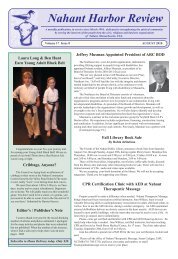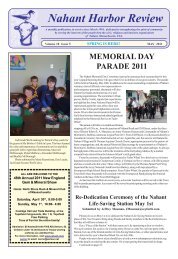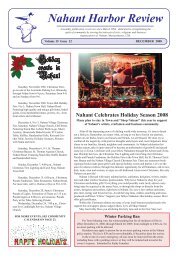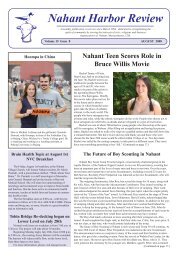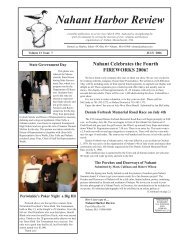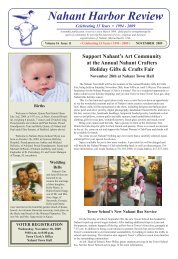FEBRUARY 2006.pmd - Nahant, Massachusetts USA
FEBRUARY 2006.pmd - Nahant, Massachusetts USA
FEBRUARY 2006.pmd - Nahant, Massachusetts USA
You also want an ePaper? Increase the reach of your titles
YUMPU automatically turns print PDFs into web optimized ePapers that Google loves.
NAHANT HARBOR REVIEW • <strong>FEBRUARY</strong> 2006 • Page 14<br />
Summer In <strong>Nahant</strong><br />
A collaboration of old photographs, letters and memories of those who<br />
lived and resorted on this seaside peninsula before us.<br />
<strong>Nahant</strong>’s Most Famous Carpenter<br />
When the new lighthouse stood finished, Dexter Stetson moved on to the other construction sites<br />
at Bodie Island and Currituck Beach and then disappeared into relative obscurity, at least from the<br />
perspective of the island inhabitants. Like most artists, he attempted to leave his name on his work by<br />
installing a small plaque. The plaque, however, was removed in 1874. As a result, little was known<br />
about the man who was behind three of the seven most well-known lighthouses in North Carolina.<br />
Over time, as the lighthouse came to be treasured by a wider audience than the seaman who<br />
navigaed by its light, people have wondered about the man who facilitated the construction. Many<br />
presumed that, like the workers who laid the brick and wielded the paintbrushes, he was from the<br />
area, maybe not an islander but surely a Southerner. They were surprised to learn that he was a carpenter<br />
from New England.<br />
Stetson was born November 8, 1815, in Durham, Maine, to Charles Stetson of Scituate, Mass.,<br />
and his wife, Abigail, of Freeport, Maine. Once source claims that Dexter was born in Freeport, which<br />
Whaaat?!? It’s<br />
not BYOB???<br />
bordered on Durham at the time. Charles and Abigail had seven children: two daughters—Asenath<br />
and Almira—and five sons—Charles C., Washington, Albert, Dexter and Solomon.<br />
As a youth Dexter was known for his love of nature and a penchant for roaming, traits he was<br />
siad to have inherited from his father. “He lived in Durham, just one town in from the water,” Margaret<br />
Wentworth of the Durham Historical Society pointed out in the strong accent of the region. “He<br />
lived in a small town adjacent to Brunswick and Freeport, only a short distance from the Portland<br />
Head and Hendricks Head lights. Dexter was surrounded by shipbuilding. In fact, an ancient road,<br />
called the ‘Mast Road’, went right through Durham. There are still traces of it today after winter<br />
leaves. Back then logs were carried from inland—and Durham has always been heavily wooded, it’s<br />
part of the great Northeastern Woods. They made up the masts of the magnificent sailing vessels, but<br />
they had to pass down this road. Dexter would have seen this every day he lived here.”<br />
Stetson’s family members worked with their hands, and he likewise earned the documented title<br />
“housewright.” He might have acquired a love for shaping wood while watching the deft shipbuilders<br />
coax straight pieces of raw wood into the sleek curves of a ship’s bow and stern. At the same time,<br />
people all around him were making their living from the sea.<br />
He hauled logs in 1840 and erected a fashionable log cabin in <strong>Nahant</strong> for a friend during the<br />
presidential election when cabins and hard cider were symbolic of the supporters of John Tyler’s bid<br />
for the White House. It is likely that memories of a grandfather’s log cabin influenced his building,<br />
but Stetson demonstrated an artistic touch when hs installed diamond-paned windows. (These windows<br />
still remain in the house now situated at 100 Castle Road, which is owned by gardener<br />
extraordinaire, Franco Macera and his sweet wife, Rose.)<br />
In the 1840s Stetson moved to Lynn, Mass., northeast of Boston. The town had a population of<br />
several thousand, and its primary industry was shoe manufacturing. In such a setting, a carpenter<br />
stood out from the masses.<br />
On July 6, 1846, he married Ann Maria Hood of <strong>Nahant</strong>—a peninsula off of Lynn—whose<br />
family was influential in the area and had significant real estate holdings. The new couple operated a<br />
boardinghouse on some property Stetson purchased from his in-laws. Their only child was born on<br />
April 4, 1847, in <strong>Nahant</strong>, and her name was Helen Louise.<br />
After Stetson settled in <strong>Nahant</strong>, he joined John Hammond, an old friend from Maine, in forming<br />
a construction business. They were credited with building the “finest summer cottages <strong>Nahant</strong> proudly<br />
claimed,” according to Stanley C. Paterson and Carl Seburg in a 1991 article written for the <strong>Nahant</strong><br />
Historical Society.<br />
Steston’s reputation may have been made in 1851 in <strong>Nahant</strong> when he was credited with building<br />
the original village church on the <strong>Nahant</strong> road in Lynn. It was a nondenominational meetinghouse,<br />
and the task carried a heavy responsibility in the community. The construction job was a prestigious<br />
project, and its completion won Stetson the community’s respect.<br />
“It was built so well for $2,258 that part of a Sunday sermon included praise for Stetson on his<br />
handiwork,” observed Calantha Sears of the <strong>Nahant</strong> Historical Society. The village church still stands<br />
today, minus its tower and clock, as a private residence.”<br />
In 1841, Stetson built a house called the Log Cabin on Pleasant Street (or School Street, its<br />
earlier name), <strong>Nahant</strong>, for the Joy family of Boston. The logs were brought from Maine by vessel.<br />
Another object of interest is that the glass doorknobs incorporated an image of Harrison.<br />
In 1892, when this house was taken down, or remodelled, Stetson retrieved its diamond-paned<br />
windows and incorporated them into a building that he had moved from the Black Rock Wharf area,<br />
where it served as a waiting station for the steamships, to Castle Road, where it served as his home.<br />
Cape Hatteras Lighthouse, NC<br />
In a letter to Rose Macera, current<br />
owner of 100 Castle Road, who resides<br />
there with her husband, Franco, Calantha<br />
Sears, Curator of the <strong>Nahant</strong> Historical<br />
Society, wrote:<br />
“This house was built in the log<br />
cabin style in 1841 by Joseph G. Joy, son<br />
of John Joy who lived on the corner of Joy<br />
and Beacon Streets, Boston. Some of the<br />
diamond shaped windows were taken<br />
from the log cabin, and put into a house<br />
made by Dexter Stetson, out of the waiting<br />
room for the boats which used to<br />
come to the wharf at Black Rock. He<br />
moved it to the corner of Castle and<br />
Harbor View Road, remodelled it and<br />
occupied it with his family.”<br />
“Alonzo Lewis, the historian and<br />
surveyor, planned this house of Joseph G.<br />
Joy in 1841. Logs were brought by vessel<br />
from Maine by Dexter Stetson, the contractor.<br />
This “Log Cabin” was of<br />
“Tippecanoe and Tyler, too” times.” The<br />
second quote is from “Some Annals of<br />
<strong>Nahant</strong>” by Fred A. Wilson, c. 1928.”



